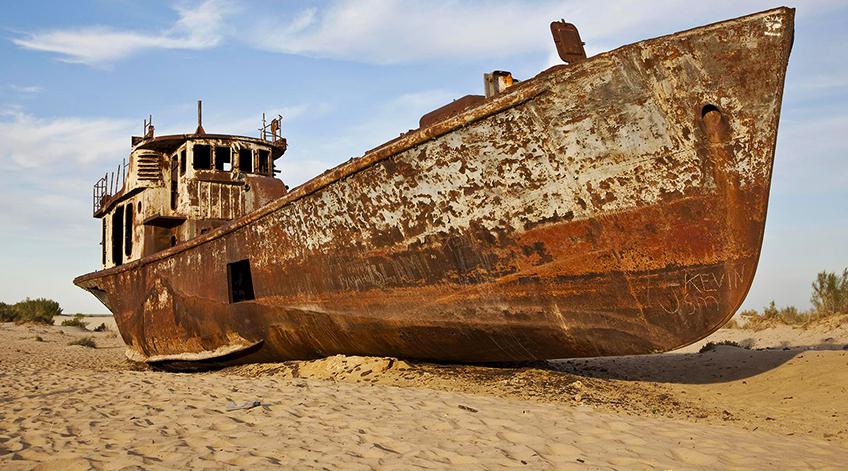

The Aral Sea is not really a sea; it was called this way because of its enormous size. Actually, it is a lake, but because it is drainless, the water there became similar to sea water in terms of salt content.
Nowadays the lake has significantly dried up; only a couple of separate ponds from the side of Kazakhstan and Uzbekistan and swampy salty areas around were left of it. The problem of the Aral Sea causes much concern to the society all over the world. The ecologists have been sounding the alarm for many years and claim that the thoughtless use of river water, which used to fill the lake, is to blame.
The Amu Darya River and the Syr Darya River, according to ecologists, were the main water sources. Ships used to prowl the Aral Sea, and by today the water has receded more than 50 kilometers. The historians and the ecologists can’t reach the agreement regarding this matter. Some of them state that this is a normal change which took place in the past; others consider the human factor to be the reason and provide no optimistic forecasts.


In 1972-1976, the Virgin Lands Campaign was conducted in the Ellikqala District of Karakalpakstan. During the land forming with a bulldozer, the tracks of terrain similar to garden bed were unexpectedly found under the layer of sand. This gave the archeologists an idea that arable farming used to flourish here not so long ago. In addition, the captains of tow boats and barges delivering cargo to Muynak and Aralsk mentioned that attractions which, judging by the outline, were strongly resembling local houses and duvals (fences) could be seen through the water at places where the depth was shallow.
The Aral Sea had already begun growing shallow at that time, and some scientists supposed that it was not the first time when the water body was shrinking. Later the remains of mosque were found within another exposed patch, and that means that life used to go on at the place of the lake.
During the studies of the remains of the former sea, which got dry after the water was gone, the 14th century fortress or settlement of Aral-asar was found. Rice was grown to the westwards of it, which is approved by the found fragments. The Golden Horde coins found here helped determine the time of the settlement existence.
The year 2001 was marked by another discovery. The archeological team of scientists from Kazakhstan explored the large well-preserved mausoleum and other fragments of an ancient settlement near the island of Barsa-Kelmes. This place was found by the local resident of the settlement of Karateren. The sensation was the fact that the found mausoleum and other constructions were under the layer of soil which was more than 20 meters thick. All the facts suggested that this place used to be not full of life, but the highly developed settlement used to exist here. Also, tree trunks were found at the exposed bottom. This was attributed to the period from the 12th to the 15th century.


In 1990, the aerial survey of the Aral Sea was conducted, during which hundreds of giant shapes which could not be seen from the land surface were unexpectedly revealed. Those shapes were united by their unusual location: straight parallel lines extended for large distances. These shapes were called the Aral Tracks.
Their total area is 500 square kilometers. The irrigation canals (several dozen kilometers long) were found. Most probably, they began at the begs of the Amu Darya River and the Syr Darya River, and the flourishing city with gardens and bustling life used to be at the place of the Aral Sea. Today most tourists visit Muynak to have a look at the ship breaking yard in the middle of the desert which reminds of the former glory of the lake.
The Aral Sea is the sad site of Uzbekistan reminding that humans are not masters of nature, but merely its part. Canaan Travel considers it important to organize journeys within the region in a way that your vacation is good for the surrounding world. By preserving nature we protect our descendants from the environmental problems we encounter.
